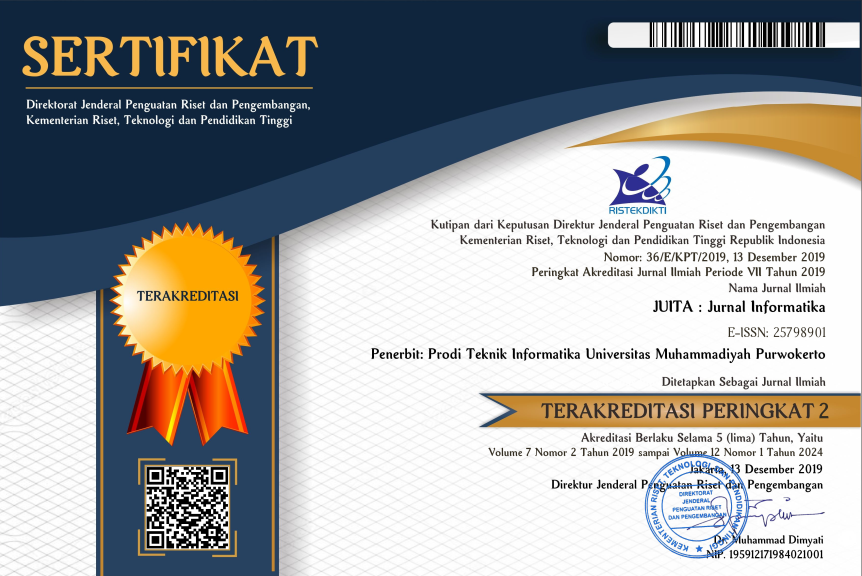Tantangan Adopsi Agile di Perguruan Tinggi di Indonesia(Challenges of Agile Adoption in Higher Education in Indonesia)
Abstract
Keywords
References
[1] R. Heeks, “Summary for Policymakers,” Clim. Chang. 2013 - Phys. Sci. Basis, no. 14, pp. 1–30, 2003.
[2] I. The Standish Group International, “Extreme chaos,” 2001. [Online]. Available: https://www.cin.ufpe.br/~gmp/docs/papers/extreme_chaos2001.pdf. [Accessed: 02-Jul-2019].
[3] I. The Standish Group International, “CHAOS REPORT 2015,” 2015. [Online]. Available: https://www.standishgroup.com/sample_research_files/CHAOSReport2015-Final.pdf. [Accessed: 03-Jul-2019].
[4] N. Joseph, “A predictive model for information technology project success,” 2013. [Online]. Available: https://ujcontent.uj.ac.za/vital/access/services/Download/uj:10916/CONTENT1. [Accessed: 13-Jun-2019].
[5] R. D. Apriyanto and H. P. Putro, “Tingkat Kegagalan dan Keberhasilan Proyek Sistem Informasi Di Indonesia,” Semin. Nas. Teknol. Inf. dan Komun. 2018 (SENTIKA 2018), vol. 2018, no. Sentika, pp. 23–24, 2018.
[6] Agile Alliance, “Agile 101.” [Online]. Available: https://www.agilealliance.org/agile101/. [Accessed: 16-May-2019].
[7] H. Hajjdiab and Al Shaima Taleb, “Adopting Agile Software Development: Issues and Challenges,” Int. J. Manag. Value Supply Chain., 2011.
[8] G. S. and A. Sidky, “Becoming Agile: ...in an imperfect world,” Manning Publ., 2009.
[9] G. Benefield, “Rolling out agile in a large enterprise,” 41st Hawaii Int. Conf. Syst. Sci. IEEE Comput. Soc., 2008.
[10] P. Serrador and J. K. Pinto, “Does Agile work? - A quantitative analysis of agile project success,” Int. J. Proj. Manag., vol. 33, no. 5, pp. 1040–1051, 2015.
[11] E. Hajrizi and F. Bytyci, “Agile Software Development Process at Financial Institution in Kosovo,” IFAC-PapersOnLine, 2015.
[12] L. S. dos Santos, A. L’Erario, T. Pagotto, J. R. M. Camilo, F. S. Oliveira, and J. A. Fabri, “A scrum-based process to distributed projects in multidisciplinary teams,” in Proceedings of the 13th Conference on Global Software Engineering - ICGSE ’18, 2018.
[13] A. Atlas, “Accidental adoption: The story of scrum at amazon.com,” in Proceedings - 2009 Agile Conference, AGILE 2009, 2009.
[14] F. Sultan and L. Chan, “Adoption of new technology: The case of object-oriented computing in software companies,” HPAC Heating, Piping, Air Cond., vol. 72, no. 2, pp. 106–126, 2000.
[15] J. McKinlay and V. Williamson, “Ten critical HR issues within libraries,” Art People Manag. Libr., pp. 191–274, 2010.
[16] I. Ghozali, Aplikasi Analisis Multivariate dengan Program IBM SPSS 19, 5th ed. Semarang: Badan Penerbit Universitas Diponegoro, 2011.
[17] V. G. Stray, “An Empirical Investigation of the Daily Stand-Up Meeting in Agile Software Development Projects,” J. Syst. Softw. o, no. September, 2015.
[18] N. Noruwana and M. Tanner, “Understanding the structured processes followed by organisations prior to engaging in agile processes: A South African Perspective,” Res. Artic., no. 48, 2012.
[19] R. Santos, F. Flentge, M. E. Begin, and V. Navarro, “Agile technical management of industrial contracts: Scrum development of ground segment software at the european space agency,” Lect. Notes Bus. Inf. Process., vol. 77 LNBIP, pp. 290–305, 2011.
[20] R. Hanslo and P. E. Mnkandla, “Scrum Adoption Challenges Detection Model: SACDM,” in Proceedings of the 2018 Federated Conference on Computer Science and Information Systems, FedCSIS 2018, 2018, pp. 949–957.
[21] M. Devi and V. Senapathi, “Understanding Sustained Usage of Agile Methodologies,” 2015. [Online]. Available: http://researchspace.auckland.ac.nz. [Accessed: 15-Jun-2019].
[22] T. E. Fægri, “Adoption of team estimation in a specialist organizational environment,” Lect. Notes Bus. Inf. Process., vol. 48 LNBIP, no. 7465, pp. 28–42, 2010.
[23] N. Khan, “SCRUM Adoption : A Solution to Backlog Problems,” 2016. [Online]. Available: https://www.researchgate.net/publication/309734111. [Accessed: 09-Jul-2019].
[24] M. Senapathi and A. Srinivasan, “Understanding post-adoptive agile usage: An exploratory cross-case analysis,” J. Syst. Softw., vol. 85, no. 6, pp. 1255–1268, 2012.
[25] M. N. Sarpiri and T. J. Gandomani, “The Impact of Team Climate on Failure and Success of Scrum Adoption,” Int. J. Softw. Eng. Appl., vol. 8, no. 3, pp. 33–38, 2017.
[26] K. S. Haryana, “Penerapan Agile Development Methods Dengan Framework Scrum pada Perancangan Perangkat Lunak Kehadiran Rapat Umum Berbasis QR-Code,” Comput. Bisnis, vol. 13, no. 2, pp. 70–79, 2019.
[27] V. N. Vithana, S. G. S. Fernando, and M. Kapurubandara, “Success Factors for Agile Software Development – A Case Study from Sri Lanka,” Int. J. Comput. Appl., vol. 113, no. 17, pp. 975–8887, 2015.
[28] T. Javdani Gandomani and M. Ziaei Nafchi, “Agile transition and adoption human-related challenges and issues: A Grounded Theory approach,” Comput. Human Behav., vol. 62, pp. 257–266, 2016.
DOI: 10.30595/juita.v8i2.7217
Refbacks
- There are currently no refbacks.

This work is licensed under a Creative Commons Attribution 4.0 International License.
ISSN: 2579-8901
- Visitor Stats
View JUITA Stats










